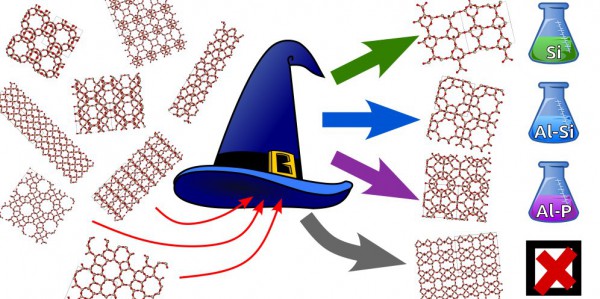Data-driven “sorting hat” ranks synthesizability of hypothetical zeolites, suggests likely chemical compositions
by Carey Sargent, EPFL, NCCR MARVEL
Zeolites, already widely used as catalysts and adsorbents, could have a significant role to play in the field of renewable energy: from applications in biomass conversion to fuel cells to CO2 capture and conversion, their controlled nanoporosity and acidic properties have attracted much interest from researchers.
For now, only 255 porous zeolite materials, made by Si, O and/or aluminum and phosphate, have been collected in the International Zeolite Association (IZA) database. This stands in stark contrast to the millions of silicate frameworks that scientists have generated computationally in their quest to find more. Even focusing on a subset of particularly stable, fully connected frameworks, leaves researchers more than 300,000 structures to work with, which is the dataset investigated in this work. Still, to date, none of these hypothetical structures has been made in the lab.
This leads to many questions on topics such as the relation between real and hypothetical zeolites in terms of structural diversity, and which hypothetical zeolites are most likely synthesizable, and in which chemical composition. Until now, researchers have relied on intuition to devise structural descriptors to answer these questions.

In the paper “Ranking the synthesizability of hypothetical zeolites with the sorting hat,” recently published in the journal Digital Discovery, NCCR MARVEL’s Michele Ceriotti and Benjamin Helfrecht, from the School of Engineering’s Laboratory of Computational Science and Modelling and colleagues develop and apply a multifaceted strategy for sifting through the hypothetical zeolites in search of the most promising candidates for synthesis. The work was a collaboration with Professor Rocio Semino and Giovanni Pireddu at Sorbonne Université, as well as with Scott Auerbach at the University of Massachusetts. Auerbach spent five months at NCCR MARVEL as a visiting professor in 2018, pursing his research on zeolites, using simulations to better understand their chemistry and investigating how they form in the first place.
The new approach, the “Zeolite Sorting Hat,” is a data science scheme that uses interatomic correlations to discriminate between real and hypothetical zeolites. The researchers found that their approach reaches 95% accuracy in distinguishing real and hypothetical structures. The 5% of hypothetical structures incorrectly identified as “real” offer a good starting point for identifying promising candidates for synthesis. After filtering these results by additional criteria, including the potential for stabilizing them during synthesis, the researchers proposed three leading hypothetical candidates for synthesis. Their analysis also categorized real (IZA) zeolites into four compositional classes. This partitioning into “houses” based on known reference compositions, bolstered by a quantification of geometric proximity to existing materials, allowed the researchers to propose the chemical composition for pursuit in the laboratory.
“As is the case for many synthetic tasks, making zeolites is a form of art, guided by experience, chemical intuition and serendipity,” the researchers said. “The Zeolite Sorting Hat introduces data-driven techniques and rational design into the process of selecting candidates that we hope will accelerate the rate of discovery that will in turn, will improve the predictive capabilities of the model in a positive feedback mechanism that will progressively take the guesswork out of zeolite synthesis.
References: BA Helfrecht, G Pireddu, R Semino, SM Auerbach, M- Ceriotti, Ranking the Synthesizability of Hypothetical Zeolites with the Sorting Hat, Digital Discovery, 2022
Low-volume newsletters, targeted to the scientific and industrial communities.
Subscribe to our newsletter